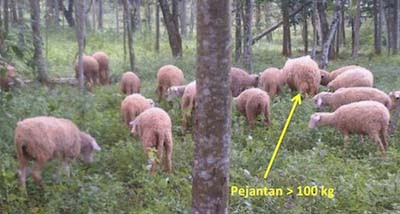"It is He Who has brought down the rain from the sky for you, some of it has become a drink and some of it has grown up, the plants which are in your place of grazing your cattle. "(Qur'an 16:10)
"Eat and graze your animals. Verily in this, there are signs of the power of Allah for those who understand. "(Qur'an, 20:54)
"Muslims are syirkah (sharia business cooperation) to three things, in terms of pasture (land), water and fire (energy)". (HR. Sunan Abu Daud).
Allah SWT grows grass (QS Al A'laa: 4) even though humans can just plant the grass but in essence Allah is the One who grows the grasses. That's because all related things to make grass grows has been created and prepared by Him. The grass is also very easy to grow and can be found in almost all places in Indonesia. In many ways this grass is even considered as a problem so a number of efforts are mobilized to overcome the problem of the grass. Even though the grasses are animal feed, especially sheep, goats, cattle and buffalo. This means that the grass is an important link for the meat production we need. In the UK even grass has contributed around 90% to their meat production, so grass cultivation for cattle grazing is professionally important in their food sector. Rotational grazing is the best technique for grazing livestock, especially sheep or sheep and cattle.
 |
| Grass Growth Cycle |
The quality and quantity of grass is ultimately an important factor for the farm business with the grazing technique. Professional shepherds must be able to identify and strive for the best grasses for their livestock. Grasses that are anatomically mostly leaves are the same as the leaves of various plants that have a cycle of growing, mature, old, dead and dry. When should the sheep eat the grass? This needs to be considered for professional grazing. Farm animals do not like old grass but also those who are too young. The condition of the medium or adult age of the grass is the best condition for animal feed because the nutritional content is also maximal. What is the consequence if livestock are lacking in consuming grass or eating enough grass but low quality? Of course the results will not be optimal, especially for the growth of the weight of the livestock.
Grass for the farm with the grazing pattern is the main feed for the livestock, while the leaves that are considered as waste from the energy plantation are the additional feed. The more feed available, the more livestock can be cultivated. Calliandra leaves have a high protein content because the roots of the leguminoceae group have the ability to bind nitrogen to the root nodules. The ability to bind nitrogen to the root nodules in addition to the roots fertilize the soil will also increase the protein content of the calliandra leaves. The high levels of protein in the leaves become a highly nutritious supplement for the sheep. By using the leaves to feed sheep and sheep dung for energy plantation fertilizers, the integration of energy plantations and sheep farms is optimal.
Mixed grazing of sheep with cattle is also very possible because both of them can optimize feed in the pasture. The habit of grazing cows with sheep is different, so are the types of grass that are their favorite feed. The anatomical factors of the mouth of the two animals are different so that it affects the grazing habits and types of grass eaten, for more clarity to read in the table below. Another advantageous factor of sheep grazing with cattle is that cows tend to protect sheep when grazing from disturbances such as wild animals, so that they have more grazing effects and are so long that the increase in body weight increases rapidly. Although grazing mixed with sheep and cattle can give positive results, but grazing mixed sheep with horses does not match and gives a negative result.


















